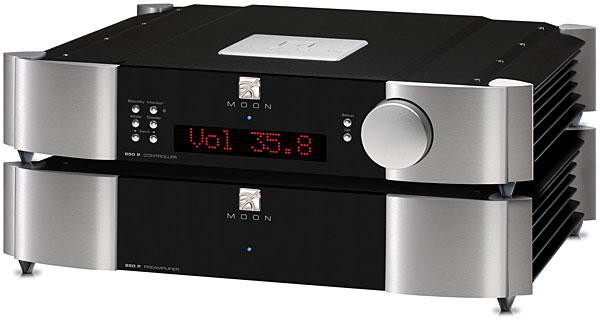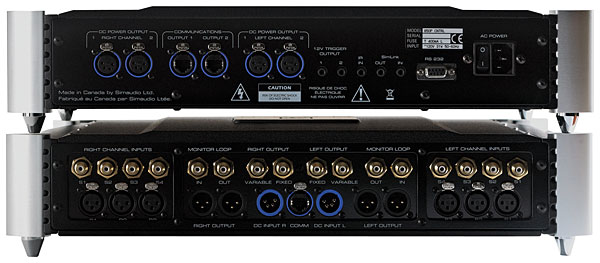Download
Popular Posts
-
Hey, we were in earthquake country, the land from which Carole King may have received inspiration to write, "I Feel the Earth Move...
-
Gibboni and the Gibbon: At Stereo Exchange’s annual Spring High-End Audio Show, Roger Gibboni (left) of Rogers High Fidelity debu...
-
The Enigmacoustics company from Irvine in California has become renowned for the self-energized, horn-loaded Sopranino electrostatic su...
-
A reader once noted that I tend to stick with the same reference gear longer than most reviewers. In addition to Audience's Au24e i...
-
Today, Sony announced an end to production on all MiniDisc players. In a few years, MiniDisc production will cease as well. I know w...
-
The name sounds perfect . It fits neatly next to those of Messrs. Leak, Sugden, Walker , Grant, Lumley, and others of Britain's...
-
Silicon Valley–based Velodyne was founded in 1983 to develop a range of subwoofers that used servo-control to reduce non-linear distorti...
-
I've heard a lot of great audio components over the years, but even in that steady stream of excellence, a few have stood out as so...
-
Once upon a time, in audio's infancy, anyone who wanted better than average sound—average sound during the 1940s being rich, boomy a...
-
I've long kept an eye on Michael Creek's loudspeakers (Epos) and electronics (Creek). He's always moving forward, with eith...
Market information
Blog Archive
-
▼
2013
(510)
-
▼
December
(15)
- This Christmas!
- Audience Au24 SE interconnect
- The Best Jazz Recordings of 2013
- Meet Mat Weisfeld, President of VPI Industries
- The Fifth Element #82
- Audio Beginnings
- My Favorite Records of 2013
- The Entry Level #36
- Lossy Compression: the Sonic Dangers
- Electrocompaniet Classic ECD 2 D/A processor
- Simaudio Moon Evolution 850P line preamplifier
- Listening #132
- Parasound Halo CD 1 CD player
- Stereophile's Products of 2013
- Wilson Audio Specialties Alexia loudspeaker
-
▼
December
(15)
Simaudio Moon Evolution 850P line preamplifier

Love at First Sight
When it comes to being swayed by a pretty face or curves that are just so, I'm as shallow as the next guy—and I was particularly taken with the good looks of the Moon Evolution 850P. Its case is similar in appearance to other Moon Evolution models, but in this case the visual design works especially well. The two chassis—the preamp itself, and its controller and power supply—are so proportioned that the stacked pair look simultaneously light and substantial, and the mix of finishes, textures, and shapes works perfectly. The balance of sleekness and solidity is carried over to the aluminum remote control, with which a vast array of functions has been cleverly arranged to be controlled with a small number of buttons.
Be Careful—Beauty Can Be Skin Deep
But the 850P's to-die-for looks are only the start. Like its Moon Evolution siblings, the 880M amplifiers, the 850P incorporates a full complement of Simaudio's latest proprietary technologies. One that's immediately obvious, even from the outside, is the mechanical damping system that the company calls M-Octave. It's not enough for Simaudio to isolate the audio circuits from the power supply and control functions by putting them in a separate chassis. Nor is it enough to split the left and right channels into completely separate circuit blocks, each with its own dedicated power supply. Two massive, antiresonant chassis aren't enough, nor are the spiked feet. In the M-Octave system, Simaudio decouples the audio circuit board from the chassis with eight compliant feet, each made of an elastomeric material and pre-loading chosen for their ability to damp the frequencies relevant to that part of the board. The system even suspends the rear panel's input and output connections from the chassis. A platinum-sledgehammer approach? Perhaps, but in a price-be-damned product—the Moon Evolution 850P costs $28,000—well, why not?
SimLink is a dedicated protocol the 850P uses to communicate with other Moon components. The power supply incorporates 40 examples of the unique filtering topology that Simaudio calls Independent Inductive DC Filtering, or i2DCf. The M-Ray volume-control circuitry, a particularly impressive bit of technology, contributes to both sound quality and ease of use. The circuit, which ranges from 0dB (no output) to 80dB (full output) in 530 steps, uses an optical encoder that reads the knob's position, then controls relays to select and insert in the signal path a combination of high-precision film resistors. A particularly nice touch is that M-Ray adjusts the volume in steps of different size, to allow the user to precisely and quickly fine-tune the level. From 0 to 30dB, the increment is 0.1dB. Between 30 and 80dB, holding the remote's Volume button down changes the increment to 1.0dB, to quickly make coarse adjustments; repeatedly pushing the button returns you to increments of 0.1dB, to more precisely adjust the level.

Flexibility of inputs and outputs is another area in which the 850P pays big dividends in usability: It has three balanced and four unbalanced inputs, a monitor/signal-processor loop, and two sets each of balanced and unbalanced outputs. Each input can be labeled and tailored in several ways using the preamp's onboard software. Using Simaudio's M-Lock protocol, a maximum volume can be set for each input, and that level can be offset by ±10dB. Each input can be programmed to activate either or both 12V triggers, bypassed for use in a home-theater system, or disabled entirely, to isolate and remove that block from the preamp's signal path.
In the 850P, even the basics—the mundane, nameless technologies and components—are selected or developed to be the best possible, regardless of cost. At the highest level are the fully balanced differential configuration, the two chassis, and the true dual-mono layout. The 850P uses top-quality parts: huge, custom-built toroidal transformers, and passive components sourced from single lots, measured, and matched.
Giving a Listen
I auditioned the Moon Evolution 850P in several different setups over the course of a few months, but when I sat down to do some serious listening, I began with a system built around the combination of 850P and 880M monoblocks. When I'd listened to this combo earlier this year, I'd been struck by how different the 880Ms sounded from other amps I'd heard. It took me a while to wrap my head around what they were doing, but I finally concluded that they were getting it right. The 880Ms' characteristics were obvious, regardless of what components surrounded them, but the 850P-880M combo was unquestionably better. However, when I assembled and optimized the system (see "Sidebar"), things got a bit interesting. After a round of tweaking that was quick and easy—any change made a BIG difference—I ended up with an eclectic mix of Nordost, Audience, and Stereovox cables, and a listening room that allowed sources and the entire system to sound their best.
I began my first listening session with Acoustic, by Everything But the Girl (CD, Atlantic 82395-2), an album I'd listened to and loved but had always thought a bit overprocessed. Ben Watt's and Tracey Thorn's voices were too smooth and sweet, and the guitar and piano each had a rich, burnished glow that was undeniably gorgeous, but not really what you'd hear at a live performance. I punched up track 5, a cover of Tom Waits's "Downtown Train." The music started just as I settled into my chair, and I froze. A few seconds later I hit Pause, sat back, and exhaled. Jesus, Mary, and Joseph! I thought. What the hell is going on?
I started the track again. This time, I got 15 seconds into it before I hit Pause and stopped to think. To say that "Downtown Train" sounded different from what I was used to is an understatement. It sounded like a completely different recording. Instead of the smooth, overprocessed character I'd always taken for granted as being an integral part of this recording, it sounded as if it had been assembled from voices and instruments that had each been recorded simply and in a natural space. Instead of sounding like pure cane sugar, Thorn's voice took on different characteristics as she changed pitch and phrasing, with a bit of a smoky, whiskey-like texture when her voice dropped deep into her chest.
The opening guitar strums had a sharp, clear attack, each string ringing clearly as it was struck. The mix of sounds composing each chord was clear and properly balanced, beginning with the attack of each string, and building in richness as the body and soundboard resonances built and evolved. Listening to another cover from Acoustic, of Bruce Springsteen's "Tougher than the Rest," I noted that the piano sounded much more alive and lifelike than the luscious but stylized version of it I'd grown used to hearing.
| | |||||||||||||
Source : stereophile[dot]com

- Không có bài viết liên quan

Comments[ 0 ]
Post a Comment